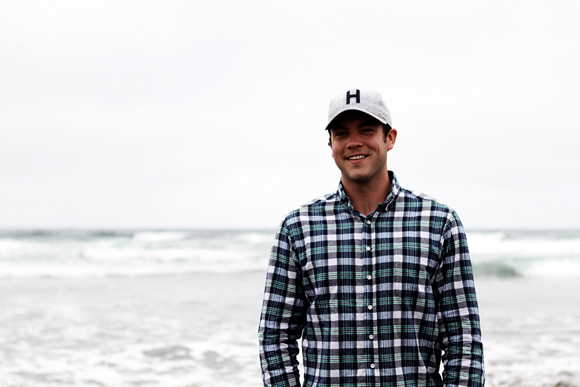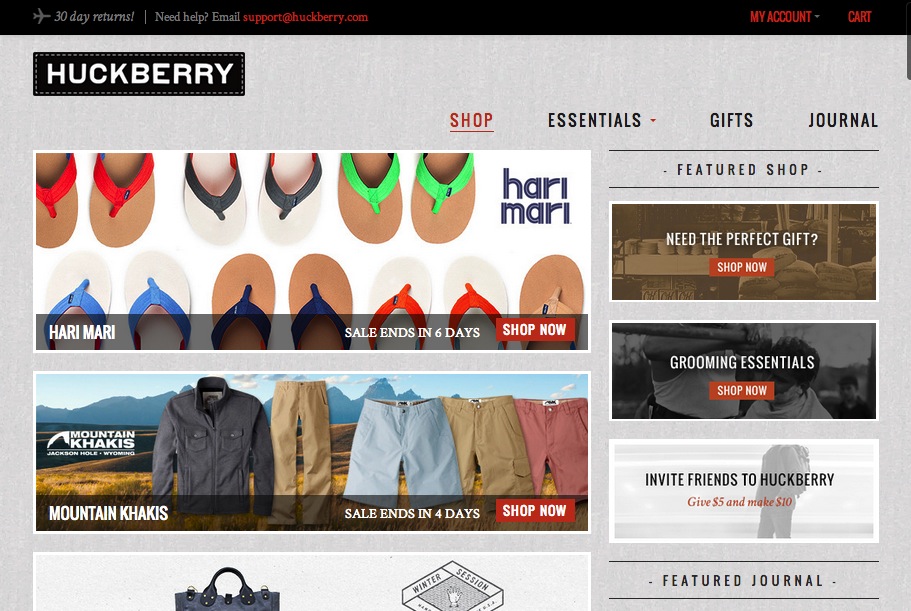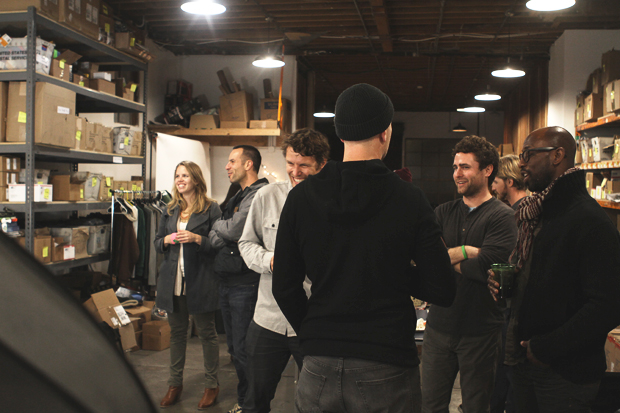No one was talking to the dudes in the middle.
At least, that’s how Andy Forch and Richard Greiner felt about the online retail offerings geared toward men: You could find plenty of high-end designer products hardly anyone can afford, and plenty of hardcore performance gear that’ll help you summit Everest. But the options in between — the options for regular, active guys like them, who bike to work in the city and hit the trails on the weekend — were hardly anywhere to be found.


Richard Greiner and Andy Forch
“We don’t need Mount Everest tents,” Greiner explains. “We need a tent where we can go on a little backpacking or car camping trip, something functional and well-designed. ... There’s no resource out there for ‘guys’ guys.’ Nobody’s talking to us in a way that is more conversational or more relaxed.”
“It was sort of the perfect storm of scratching our own itch and knowing there was a void to be filled because we were the target market,” says Forch. “We both knew we wanted to get our hands dirty with starting a business.”
The two were working in investment banking in San Francisco when they hatched the idea for Huckberry — a members-only, bi-weekly web magazine featuring curated apparel and gear, along with the stories behind the products.

The guys quit their jobs and used the coffee shop between their apartments as their office. Forch learned Photoshop and designed the website; Greiner called up brands and set up suppliers. Inventory started arriving at their home addresses.
“My girlfriend at the time wouldn’t come over to my house, because there were just boxes everywhere,” recalls Greiner.
‘A big dirty warehouse’
Huckberry launched in summer 2011, about five months after its cofounders quit their jobs. They invested $20,000 each at the beginning, from their personal savings. Taking VC was never much of a consideration.
“We took a few calls,” says Greiner, but “coming from the investment banking world, the thought of taking money was unattractive. ... I wanted to see if we could bootstrap it and see where we could get to. The one thing we sought more than money was advice, and we didn’t find anyone who we thought offered a lot of insight.”
Their expenses were minimal at the outset, since they weren’t paying themselves and didn’t have an office. They started turning a profit within three months.
Huckberry’s business model helped leverage the company in the beginning as well — as opposed to traditional retail, where the retailer pays the vendor and the vendor sells to the customer, Huckberry’s customers pay them first and then Huckberry pays their vendors. “Our business model is fixed cost-light and variable cost-heavy,” Greiner says. “Once you get going, you have tons of costs! But a lot of those are the result of doing business.”
They began hiring, slowly at first. “It was a big day when we got our first office,” Greiner recalls. “It’s a big moment when you realize, ‘we have a little business here!’” The reality of a dedicated space — though only 350 square feet — inspired a growth spurt, and Huckberry brought on more people. “Next thing you know, the office space is more like a closet. By the time there were five of us in this teeny office — we do all the fulfillment ourselves — this place was a zoo. It was insane with all the inventory.”

They moved to what Greiner calls “a big dirty warehouse,” which they’re also in the process of outgrowing—it’ll be time for Huckberry to move again soon. But at least the current space is big enough for a rock wall.
‘We are what we’re selling’
“Everyone here is active,” Greiner says. “We are what we’re selling. We’re weekend warriors. Everyone just kind of fits our vibe.”
“The funny thing is,” says Forch, “Rich and I came from very formal worlds, where it’s all about pedigree — ‘where’d you go to school?’ Now I’m never asked where I went to school. Here it’s like, ‘hey, you pass the airplane beer test.’ Would I wanna get stuck with you in a snowstorm? Are you gonna tell a good story?”
“We make decisions all the time that if you were an e-commerce guru, you’d hate Huckberry,” laughs Greiner. Huckberry’s twice-weekly email edition, for example, features four to six brands and their respective stories, blog posts, and a section called “Diversions” — links to interesting stories elsewhere on the web. Traditional e-commerce “rules” stress always sending readers to your site. But, says Forch, customers open Huckberry’s emails at 5-10 times the rate they do competitors’ emails.
The idea is that even if customers aren’t interested in anything Huckberry is selling, they’ll still find value in the email, and the company. “All these little tricks that e-commerce guys do, we pretty much say no to all of them,” Greiner says. “We’re trying to get people’s mind share instead of wallet share. You’re building a relationship with these people. ... Our mentality, that we are what we’re selling — people can really feel that and identify with that.”
“We try to have fun,” Forch adds. “We’re trying to build a lifestyle brand, and authenticity is a big part of that. How do you try out a new product? You take the team camping in the Sierras. We hire people to work with us, not for us — people who are doers, who go out there and get after it. It’s a fun environment.”
‘Fighting with our hands tied behind our backs’
Doers don’t come cheap, though — especially in the Bay Area.
“Bootstrapping a company is hard,” Forch says. “Bootstrapping a company in San Francisco is really hard.” Silicon Valley money raises salaries for everyone in the region, making it a tough place to compete for quality employees who’ll stick around. “Getting that talent and culture to your company is a big challenge for us.”
Being the little guy is always an obstacle as well. As a young bootstrapped company, Greiner says, “sometimes it feels like we’re fighting with our hands tied behind our backs.” Many of Huckberry’s competitors — men’s magazines, other “flash sale” sites like Fab.com — are better funded, and Huckberry doesn’t have millions to put toward advertising.
Instead, they’re focused on growing in a “natural and organic” way, says Greiner: “finding and establishing partnerships with like-minded people who have the same values. We don’t take the buckshot approach. We go out and find people that we really believe in, that we really trust, and we partner with them on an intimate basis.”
The next eight innings
At this point, the cofounders have no plans to sell — they make all decisions as though they’ll be running Huckberry indefinitely. The company employs 12 people and enjoys a run rate of mid- to high-seven figures in revenue, just a couple years after launching. Forch and Greiner are pleased with that kind of progress, but they operate as though they’re in the first inning of a nine-inning ball game.
Next steps include expanding the content side of the business, and exploring other initiatives like a brick-and-mortar presence, a private label, and event hosting — whiskey tastings, a concert series, fly fishing demos — “all these touch points that people can really identify with,” Forch says. “We’d like to go into something knowing we could be one of the best at it.”
‘You always throw out your first pancake’
“The great thing about being small and nimble,” says Forch, is “if you try something and it doesn’t work — OK!” Huckberry’s size allows for experimentation and gives the company a certain level of agility. A few months after launching, for example, they tried out a different sales model — and caught hell from their customers. They went back to their original plan right away. “You sort of know that when you find something that works, do more of it, and when you find something that doesn’t work, don’t do more of that.
“You always throw out your first pancake,” Greiner says, echoing advice he received earlier in his career. “Point is, just go out and do it. Start it. Don’t worry about problems that you don’t have. Don’t overthink and overplan. Your first business plan, your first design, is gonna be thrown out. You learn so much by doing, so get out there and do it.”
Visit Huckberry.
“Bootstrapped, Profitable & Proud” is a Signal Vs. Noise series highlighting profitable companies with $1 million+ in revenues that didn’t take VC.

Michael
on 22 Jul 13I’m so glad to see this series back. Thanks for sharing their story.
Guillaume
on 22 Jul 13Yes, just inspirational. Thank you.
Anonymous Coward
on 22 Jul 13At what dollar amount do you say, holy crap – that’s a lot of money you personally put up and risked?
$20k, $50k, $100+k?
Mr Matt
on 22 Jul 13Marvelous story! Excellent share Em.
@Anon Coward—Risk it for the biscuit you pussy.
Tom
on 22 Jul 13Having worked with these guys they really stood out from other “flash sales” sites. They are very worthy of the success they’ve achieved. Thanks for sharing the story.
Dan
on 22 Jul 13Thanks- I’d be interested to know a bit more about the early days. How did they get their first customers and what kinds of advertising did they do? There’s probably a lot of info between “invested $20k” and “soon they were profitable.”
Michael
on 22 Jul 13Anon, it’s all relative. When I risked $1,000, it was a big deal to me. People who leave higher-paying jobs (i-banking) have an advantage, especially when two people put up money and split some costs.
I know a local entrepreneur who thought nothing of risking $80,000. She probably had over a million saved by that point, though, and the leap meant a lot to her.
International Photographer
on 23 Jul 13As an first generation entrepreneur, i can full understand your decision for not taking the VC way. Always better to start off small and plan for the bigger things. I run a small Digital Studio in Mumbai, India and have completely invested every single penny myself.
Brandon Hansen
on 23 Jul 13That $20k jumped out at me as well. I think that it may be a little easier to be bootstrapped and profitable when you have $40k to be bootstrapped with (my own $3k hurt bad enough). For a lot of us, that really isn’t an option.
That said, there is a lot to be said about not being tied down to investors and being able to grow your own company in the way you want and at the pace that you want.
Julia
on 23 Jul 13The highlight of the day – realising that this page is being continued after all :)
Great story, love the rock wall. But I agree with Dan, I would love to hear about how those first partnerships were made.
Romain
on 23 Jul 13Most business ventures require capital to start up. Software, at least simple enough software, is an exception; one can start with essentially just a laptop. Accumulating savings in order to invest them in your company is also what bootstrapping is about.
Alex
on 23 Jul 13Thanks for sharing this article and bring back this bootstrap series! I always appreciate to hear incredible stories during this so called “crisis”. Cheers, Alex.
Rob
on 23 Jul 13I’m so glad to see this series come back. Regarding the capital required to start up a company: it’s going to differ wildly. As someone who’s started both software and manufacturing companies, the capital required for the latter can be significantly greater. My wife and I pumped most of our personal savings into our new golf ball company. It’s a huge leap of faith but there’s nothing quite like being personally vested and pot-committed. All the best, ~Rob
Big O
on 23 Jul 13Nice article Ma Em. I liked these guy’s perspective, relevant for me now.
Andy Forch
on 23 Jul 13Hey Guys -
Thanks for all of the support. The BP&P series inspired Richard and I very early on, and it’s an honor to sit aside some of the other incredible companies that have been profiled in the past.
I’ll do my best to answer the questions that have been posted in the comments so far…
@Anon Coward – $20k is indeed a lot of money. When Richard and I started out, we put up something more like $5k each and as the expenses piled up in developing the website, invested a bit more over time. We also made the mistake very early on of hiring a designer to develop our brand identity and early wireframes, but ultimately parted with him and didn’t use his work despite paying him a bunch of cash. That hurt.
When we launched, we also had to overcome the classic chicken and egg problem – we had no members to attract brands and vice versa – so we placed orders that were larger than the demand, which also ate into and required some extra cash.
@Tom – thanks for the kind words and the email yesterday :)
@Dan – the short answer is hustle. To get our first 2.5k members, we reached out to all of our friends and family and asked them to sign up. To incentivize them to purchase, we gave everyone the family & friends discount, which looking back, seems appropriate as everyone of our first customers was a family or friend :)
Getting beyond the first 2.5k members was much more difficult. It’s one thing for your family and friends to support your idea and business, but getting complete strangers to hand over their money is truly where the rubber meets the road. Thankfully, people enjoyed our emails (which remain awesome and infrequent) and forward them to friends which gave us a pretty healthy organic sign up rate.
Our next big break was partnering with two of our favorite websites: Outside Magazine and the Art of Manliness. Since we were subscribers to Outside ourselves, we knew that Outside readers would love the brands we carried, and we were able to work out a deal where Outside subscribers who purchased their subscriptions online were redirected a Huckberry landing page that gave them credit for signing up with us, and where any purchases they made on Huckberry would earn Outside a split of the profits.
Our partnership with the Art of Manliness, one of the largest (and best) men’s lifestyle blogs on the web, took a little longer to develop. We reached out to AOM founder Brett McKay very early on about sponsoring a giveaway on his site, and he declined but said that he’d sign up and follow long. Then one day we noticed that were getting a ton of hits from AOM and checked out his site to see that he had named us one of his favorite men’s shopping sites (the article is here: http://bit.ly/1dSB01E). We reached back out to Brett to see if we could pick up the conversation about the different ways we could work together and the rest is history. Today, we advertise on AOM, sponsor weekly giveaways, and have AOM guest curate editions for us. The relationship has grown from a partnership to a friendship, and we wouldn’t be where we are today without Brett and our friends at the Art of Manliness.
More to come, particularly on the way in which having great content has fueled our growth. Rich and I are off to a couple of trade-shows in NYC, but will resume the Q+A when we return.Mark Paigen
on 23 Jul 13As a serial entrepreneur, I can relate to the desire to bootstrap without outside investment. The prominent success stories in the news about VC money winning big are outnumbered by the unheard stories of small business having bad outcomes with aggressive investors. As a vendor on the Huckberry site, I can say that I have received stand up service, a fair deal and a personal connection. A pleasure in today’s world. A $40k investment may seem like a chunk of change, but it is small amount to launch a successful business these days. I applaud their ability to find a niche and create a profit quickly. Best of luck…
Taylor Llewellyn
on 23 Jul 13I have partnered with Huckberry with two different businesses. It’s a great company with a truly authentic brand identity. Andy and Richard are some of the best young entrepreneurs i’ve worked with in the last 5-6 years. Excited to see where they take this!
Nana Ewusi
on 23 Jul 13Very refreshing & inspiring story. Thanks @Andy for shedding more light on the challenges you faced and how you dealt with them. Helps a great deal :)
Lloyd Phillips
on 23 Jul 13I’m so glad to see this series back as well it’s super motivating and insightful. I agree with the other posters that it’d be good to get a little more insight into how they grew, what worked, what didn’t. But it’s awesome that Andy has dropped in to follow up with questions and further insight.
Cesar Contreras
on 24 Jul 13Today’s economy is about personal connection, trust, and working hard on something you love. Huckberry is a great example of the American dream.
Michael
on 24 Jul 13Andy, I remember seeing you all on Art of Manliness now. That is a perfect partnership. Good job being ready for it.
Robbie Vogel
on 29 Jul 13Great piece on what sounds like an awesome company. I actually work for Vistaprint, and the vast majority of our customers are businesses with less than 15 employees, so it’s great to see a small business like Huckberry flourishing. Keep it up, guys!
This discussion is closed.